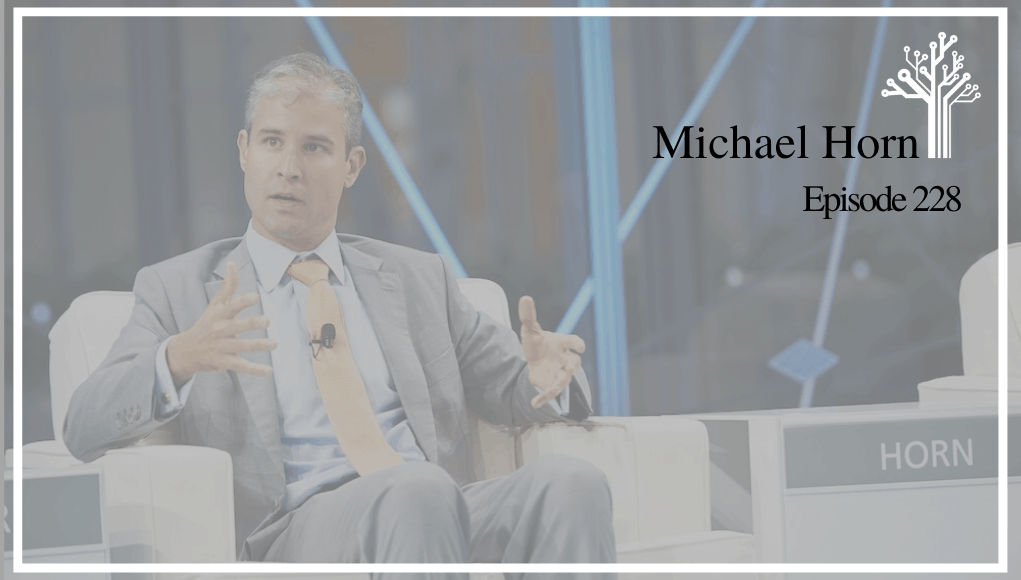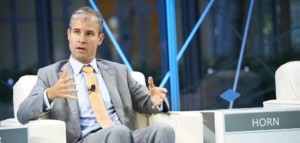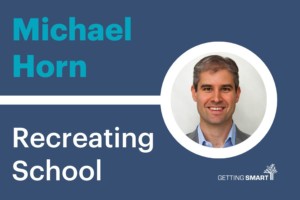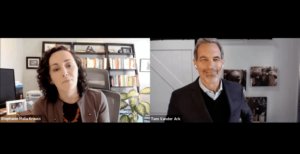Podcast: Michael Horn on Choosing College

After Yale, Michael Horn thought about law school but gained admission to Harvard Business School. He’s thought a lot about that process and how it shaped his life. His new book, Choosing College, unpacks all the reasons people go to college and offers advice to college seekers and operators.
Horn had the good fortune to be sitting in the second row of Clayton Christensen’s innovation course when he asked if anyone wanted to co-author a book on K-12—and the foresight to visit him after class to volunteer. Two years later, Disrupting Class was published. Ten years later, we all talk about disruptive innovation (as if we understood it).
After co-founding the Christensen Institute, Horn directed the education program for a dozen years, applying innovation theory to policy and practice in K-12 and higher education.
After writing American Enterprise paper on Disrupting College with Christensen, Horn shifted the majority of his time to advising higher education leaders. With Bob Moesta, he began applying Christensen’s ‘jobs to be done’ framework to the increasingly complex landscape of postsecondary learning. After a series of deep interviews, they identified five reasons people choose the colleges they do—the ‘jobs people hire college to do’:
- Help me get into my best school: the classic experience relying on traditional rankings;
- Help me do what’s expected of me: fulfilling parent and teacher expectations (a terrible and often expensive reason to go to school);
- Help me get away: a move away from an unpleasant situation, but not necessarily toward something positive;
- Help me step it up: with anticipated events, a decision to be better; and
- Help me extend myself: the personal decision to invest in self-improvement.
The main point of the book for college seekers: to get clear about the question “why college?” Also: “what is it you really want from the experience?” And until you’re really clear about that, avoid racking up lots of debt at an expensive school.
While they don’t deal extensively with the high school guidance function in the book, Horn said helping young people figure out who they are and what they want out of a postsecondary experience is critical.
“We’ve narrowed the curriculum and discounted experiential learning experiences,” said Horn. To answer the Choosing College questions, “young people need more of these exploratory experiences,” added Horn.
For parents, guardians, teachers, and advisors, Horn said, “We cannot leave college choosing to luck.”
The Equity Dilemma That Comes With Nuance
Not all kids need to go to college, at least not right out of high school. That observation has kicked up some criticism of the book from equity advocates, Horn said.
One of the problems with pushing for college for all is the new worst-case scenario: debt without a degree. Another problem is that it doesn’t recognize all the new earn-and-learn tech career ladders available.
Some of his ed reform colleagues have said, “It’s great for upper-income students to focus on developing a sense of purpose; low-income kids just need to go to college.”
Horn thinks clarity of purpose is important for all young people to avoid wasting time and money on a poorly fitting postsecondary choice. But that requires broad experiences, relationship-based advising, and the resources to provide them.
The key, explained Horn, is to “create a system where all students are aware of and exposed to different pathways without predetermining them.”
The book features the career education focus of Cajon Valley USD (@cajonvalleyusd), where Kindergarten through eighth-grade students cycle through more than 50 career explorations while reflecting on strengths, interests, and values.
Advice to Operators
With all of these reasons people have for attending, most colleges serve very different customer segments but typically don’t recognize the varied motivations.
“Colleges try to be all things to all people, but this different jobs-to-be-done are pulling against each other, resulting in one-size-fits-none and driving up overhead dealing with all the complexity,” Horn said.
Horn is sympathetic to Ryan Craig’s call for expanded access to free or debt-free sprints to a good first job. In many cases, that will involve a high school and community college in partnership with an employer (see recent features on Infosys and Dallas ISD). Horn sees innovations like these creating new options and advancing competency-based learning.
Horn argues that, like college seekers, college operators need to get clear about their sense of purpose. And with greater clarity, focus on innovations that deliver value.
If someone you know is thinking about higher education, get them a copy of Choosing College How to Make Better Learning Decisions Throughout Your Life. It informs college choosers as well as college leaders.
Key Takeaways:
[2:30] What was Michael’s musical interest that drew him to Yale?
[2:58] What job did Michael want a Harvard MBA for?
[4:12] Is Harvard Business School where Michael met Clayton Christensen?
[5:08] Tom and Michael speak about the early process of writing Disrupting Class.
[5:57] Michael speaks about the experience of working on Disrupting Class with Clay.
[6:43] Michael speaks about his time spent at Christensen Institute.
[7:12] Michael’s biggest takeaway from a dozen years spent at Christensen Institute.
[8:08] Tom and Michael discuss what disruptive innovation is and why it is so important.
[9:12] Why did Michael make the shift from K-12 to higher-ed in the last four years?
[10:57] Tom and Michael discuss how reimagining higher ed may be the key to transforming the secondary school experience.
[13:18] Why college may not be the right choice for all students right away after high school.
[14:52] Why Michael decided to write a book more for college seekers rather than college operators.
[17:50] Michael outlines the five reasons why students decide to go to college from his book, Choosing College.
[20:12] Michael speaks about the guidance gap in high school and how he thinks high school advisors, educators, and guidance counselors understand this.
[23:55] What high school should be at its core.
[26:24] Michael responds to criticism of his book, Choosing College.
[27:00] Tom and Michael speak about why high schools should be helping students understand their sense of purpose and the importance of making a contribution to the world.
[29:40] Tom and Michael speak about the shift to life-long learning in education.
[31:25] Michael gives his take on Ryan Craig’s book, A New U.
[36:30] How the higher ed landscape is changing and how the lines are blurring between high school and college.
Mentioned in This Episode:
Disrupting Class: How Disruptive Innovation Will Change the Way the World Learns, by Michael Horn, Clayton Christensen, and Curtis Johnson
“Disrupting College” Paper by Michael Horn, Clayton Christensen, Louis Soares, and Louis Caldera
Choosing College: How to Make Better Learning Decisions Throughout Your Life, by Michael Horn and Bob Moesta
Yale University
Harvard Business School
Christensen Institute
Michael B. Horn
Clayton Christensen
Gisèle Huff
Who You Know: Unlocking Innovations That Expand Students’ Networks, by Julie Freeland Fisher
A New U: Faster + Cheaper Alternatives to College, by Ryan Craig
Dallas ISD
Dr. Michael Hinojosa
Grit: The Power of Passion and Perseverance, by Angela Duckworth
For more postsecondary choices, see
- Does College Still Pay? Seven New Rules for Making a Good College Choices
- Ryan Craig on Last-Mile Training as an Alternative to Higher Ed (Podcast)
- How Faster + Cheaper Alternatives Will Replace Most of HigherEd
- Podcast: Michael Hinojosa on Making Dallas Schools Work
Stay in-the-know with innovations in learning by signing up for the weekly Smart Update.
This blog was originally published on Forbes.








0 Comments
Leave a Comment
Your email address will not be published. All fields are required.